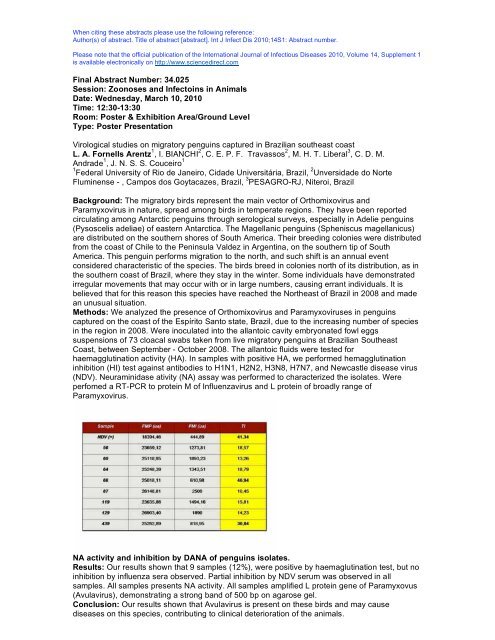14th ICID - Poster Abstracts - International Society for Infectious ...
14th ICID - Poster Abstracts - International Society for Infectious ...
14th ICID - Poster Abstracts - International Society for Infectious ...
You also want an ePaper? Increase the reach of your titles
YUMPU automatically turns print PDFs into web optimized ePapers that Google loves.
When citing these abstracts please use the following reference:<br />
Author(s) of abstract. Title of abstract [abstract]. Int J Infect Dis 2010;14S1: Abstract number.<br />
Please note that the official publication of the <strong>International</strong> Journal of <strong>Infectious</strong> Diseases 2010, Volume 14, Supplement 1<br />
is available electronically on http://www.sciencedirect.com<br />
Final Abstract Number: 34.025<br />
Session: Zoonoses and Infectoins in Animals<br />
Date: Wednesday, March 10, 2010<br />
Time: 12:30-13:30<br />
Room: <strong>Poster</strong> & Exhibition Area/Ground Level<br />
Type: <strong>Poster</strong> Presentation<br />
Virological studies on migratory penguins captured in Brazilian southeast coast<br />
L. A. Fornells Arentz 1 , I. BIANCHI 2 , C. E. P. F. Travassos 2 , M. H. T. Liberal 3 , C. D. M.<br />
Andrade 1 , J. N. S. S. Couceiro 1<br />
1 Federal University of Rio de Janeiro, Cidade Universitária, Brazil, 2 Unversidade do Norte<br />
Fluminense - , Campos dos Goytacazes, Brazil, 3 PESAGRO-RJ, Niteroi, Brazil<br />
Background: The migratory birds represent the main vector of Orthomixovirus and<br />
Paramyxovirus in nature, spread among birds in temperate regions. They have been reported<br />
circulating among Antarctic penguins through serological surveys, especially in Adelie penguins<br />
(Pysoscelis adeliae) of eastern Antarctica. The Magellanic penguins (Spheniscus magellanicus)<br />
are distributed on the southern shores of South America. Their breeding colonies were distributed<br />
from the coast of Chile to the Peninsula Valdez in Argentina, on the southern tip of South<br />
America. This penguin per<strong>for</strong>ms migration to the north, and such shift is an annual event<br />
considered characteristic of the species. The birds breed in colonies north of its distribution, as in<br />
the southern coast of Brazil, where they stay in the winter. Some individuals have demonstrated<br />
irregular movements that may occur with or in large numbers, causing errant individuals. It is<br />
believed that <strong>for</strong> this reason this species have reached the Northeast of Brazil in 2008 and made<br />
an unusual situation.<br />
Methods: We analyzed the presence of Orthomixovirus and Paramyxoviruses in penguins<br />
captured on the coast of the Espírito Santo state, Brazil, due to the increasing number of species<br />
in the region in 2008. Were inoculated into the allantoic cavity embryonated fowl eggs<br />
suspensions of 73 cloacal swabs taken from live migratory penguins at Brazilian Southeast<br />
Coast, between September - October 2008. The allantoic fluids were tested <strong>for</strong><br />
haemagglutination activity (HA). In samples with positive HA, we per<strong>for</strong>med hemagglutination<br />
inhibition (HI) test against antibodies to H1N1, H2N2, H3N8, H7N7, and Newcastle disease virus<br />
(NDV). Neuraminidase ativity (NA) assay was per<strong>for</strong>med to characterized the isolates. Were<br />
perfomed a RT-PCR to protein M of Influenzavirus and L protein of broadly range of<br />
Paramyxovirus.<br />
NA activity and inhibition by DANA of penguins isolates.<br />
Results: Our results shown that 9 samples (12%), were positive by haemaglutination test, but no<br />
inhibition by influenza sera observed. Partial inhibition by NDV serum was observed in all<br />
samples. All samples presents NA activity. All samples amplified L protein gene of Paramyxovus<br />
(Avulavirus), demonstrating a strong band of 500 bp on agarose gel.<br />
Conclusion: Our results shown that Avulavirus is present on these birds and may cause<br />
diseases on this species, contributing to clinical deterioration of the animals.
















